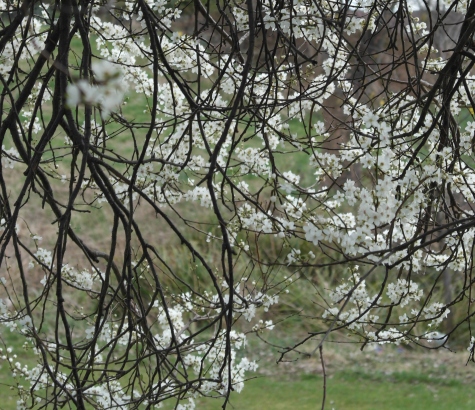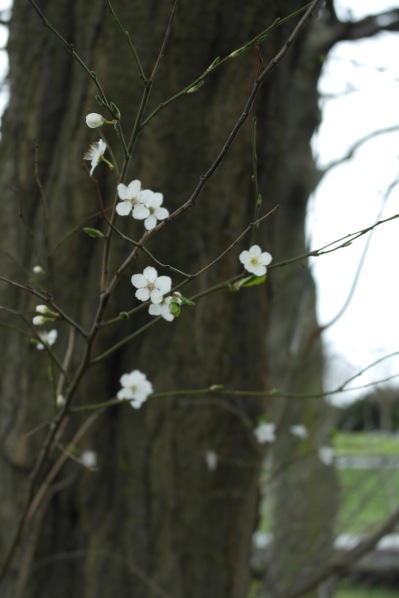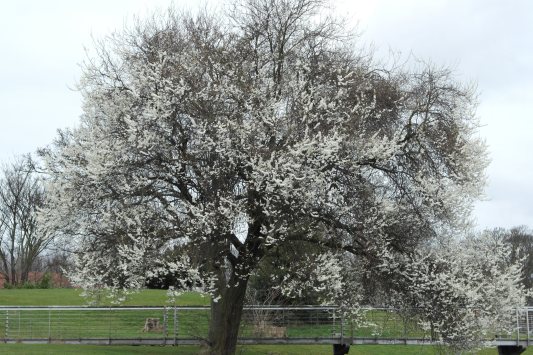Spring has daubed the landscape with splashes of yellow. Daffodils slowly blooming; a smattering of coltsfoot; the first marsh marigolds squatting in the mud and a handful of cowslips emerging from papery shells. But the blackthorn has been my true herald of spring. It blossoms early, before the other spring flowers have awakened, before its leaves have unfurled. Look at the hedgerows and you’ll see it alongside its sister hawthorn, the rich green of the hawthorn leaves contrasting with the blackthorn’s leafless blooms. But here, guarding the bridge over the burn, I’ve met my own blackthorn, my own witch’s tree.
Blackthorn is known as the Mother of the Woods because its thickets can create the conditions for other trees to grow. Often, it’s no more than a tangled hedgerow shrub, pretty but unexceptional. As a mature tree though, its presence is unmistakable. The charcoal gnarling of the trunk and limbs are a deep contrast to its flowers. Spindly branches shiver with blossoms. It’s a tree of protection, a tree to linger beneath. It enfolds and shelters me like a snowy parasol. I feel secluded, viewing the world through tumbling branches and a veil of milky blooms.
The blackthorn is burdened with a sinister reputation. Its thorns are sharp and plentiful and it was said that the devil used them to mark the fingers of his followers. They were placed beneath the saddles of horses so that they would throw their riders and dipped in poison to pierce human flesh. It’s said that the crown of thorns worn by Jesus was fashioned from hawthorn and blackthorn. Fighting sticks and clubs were made from its wood. It was supposedly used in black magic and witches were burned on its pyres as a final humiliation, the witches’ tree turned against them. Blackthorn is the ‘keeper of dark secrets’. But standing here beneath its branches, I know that this tree isn’t dark, it’s luminous.
Not all blackthorn’s associations are sinister. Garlands of hawthorn and blackthorn were placed at the top of the maypole at Beltane to stimulate fertility. It was said to blossom miraculously at midnight on Christmas Eve, along with the Glastonbury Thorn. At new year it was burned to bring fertility to the land and hung with mistletoe to bring good luck. Blackthorn is also a strongly protective tree. In some tales, it was the hedge that protected Sleeping Beauty as she slumbered. Blackthorn is balance: hawthorn is often seen to symbolise the light half of the year, while blackthorn is the dark. Yet blackthorn has both light and dark within itself.
It’s no surprise that I’ve been drawn to the blackthorn this spring. There is a darkness in it, symbolised by its wicked thorns and bitter fruits. It’s the darkness of stagnancy and self-doubt that lies within us. The twisted branches symbolise that the journey out of darkness isn’t quick or easy. Blackthorn is a powerful tree and its guardianship isn’t to be taken lightly. Its protection lies in fierce thickets of impenetrable briars. But its blossoms are hope, bursting into bloom while the season is still frigid. The luminosity of its flowers is an embodiment of the purification and creativity it brings. Its thorns can wound, but they can also tear a path through the thicket. If you accept the guidance of the blackthorn, you need to be prepared for challenge and uncomfortable change but you’ll be rewarded by abundance.
Last year my eyes were drawn downward, to the small wild things that spring from the earth. This year, the trees are calling and the Mother of the Woods is my first teacher.










So are you saying that the thorns Jesus wore are the thorns protecting Sleeping Beauty? There must be a metaphor or something in there somewhere!
LikeLike
Indeed – such a rich folklore that I guess there are lots of links to be made.
LikeLiked by 1 person
I found that poem today, but it’s a bit dark (sorry).
LikeLike
I loved your poem Laine, it fits into the wide mythology of the tree!
LikeLiked by 1 person
Pingback: Blackthorn | From Midnight to Dawnlight
Beautiful tree and you have described it beautifully, Andrea 🙂
LikeLike
Thanks Wendy 🙂
LikeLiked by 1 person
Great post and absolutely beautiful pictures! Thanks for sharing.
LikeLike
Thank you Cecilia.
LikeLike
The blackthorn is truly magnificent. Loved how you wove in its backstory and your personal story. Beautifully written, Andrea. 🙂
LikeLike
Thanks Kourtney 🙂
LikeLike
I was sure I had to put a like on this one! but there it is!
LikeLike
*had put!!
LikeLiked by 1 person
Andrea, You never let us down. Your photos and descriptions are positively delicious time after time.
LikeLike
Thanks so much Sheri 🙂
LikeLiked by 1 person
This is a wonderful post about mysterious trees named blackthorn which I have never heard before. There is a noticeable detail that blackthorn guarded the way to the Sleeping beauty, such a romantic myth! The last paragraph is my most favourite, blackthorn might symbolise the life itself cause there are no rewards without pain! Thank for writing this notable post!
LikeLike
Thanks so much for your comments 🙂
LikeLiked by 1 person
Beautiful tribute to a beautiful tree. I love them too – blooming in the hills, mixed with gorse like honey and milk. The most beautiful symbol of spring!
LikeLike
That’s a lovely image Inese, ‘honey and milk’ – the gorse is also beautiful at the moment.
LikeLiked by 1 person
This is definitely the beginning of a story. Or a moral or a fable. Or something. Boy, am I going to love following your blog! “If you accept the guidance of the blackthorn, you need to be prepared for challenge and uncomfortable change but you’ll be rewarded by abundance.”
LikeLike
Thanks so much and welcome!
LikeLike
Andrea, I doubt that my comment is adding anything fruitful to the dialogue, but I just had to say that your staggering knowledge of all things natural makes manifest your philosophy of reverence toward nature (and ruins for that matter, or the ancient human-made offshoots of nature, working with stone and other organic materials). It is really just awe-ing to ride along (that is, as a reader of your posts) as you weave words into captivating garlands; I can see why you’ve been published over and over again. You’re a fabulous writer with a keen sense for the magic and musicality of life. I see your writing well placed within the pantheon of nature/environmental writers, biologists, and so-called nature poets: Rachel Carson, Aldo Leopold, Thoreau, Wordsworth, Keats, and others of whom my knowledge is sadly limited.
LikeLike
Wow, thanks Leigh, those are wonderful compliments indeed!
LikeLiked by 1 person
I appreciated all your information on the trees. I love the luminosity of the blossoms. And the darkness of the trees seem to make them even more luminous. Enjoyed this.
LikeLike
Thanks Anne. They are beautiful.
LikeLike
oh my… so beautiful trees and those flowers,and your words. Perfect.
LikeLike
Thank you very much.
LikeLike